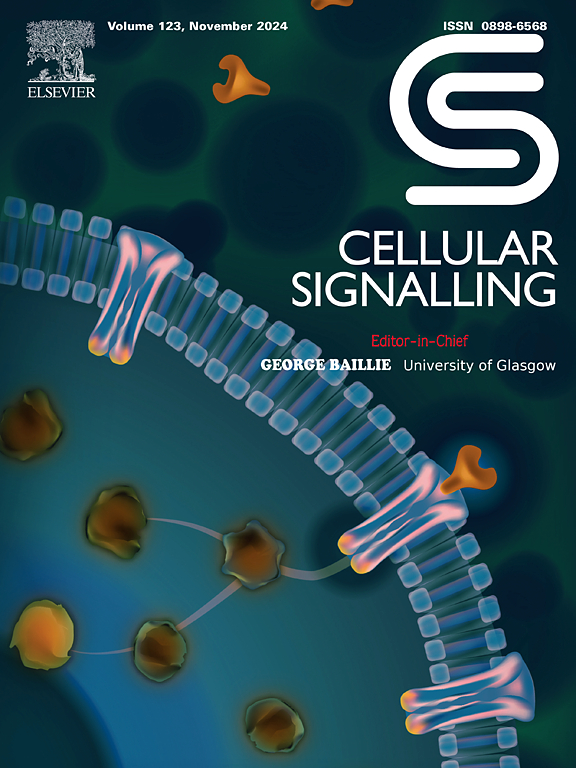抑制HDAC6可通过Sp1/SOD3/MKP1信号轴下调ERK磷酸化,从而对头颈部癌细胞产生抗癌作用。
IF 4.4
2区 生物学
Q2 CELL BIOLOGY
引用次数: 0
摘要
活性氧(ROS)和超氧化物引起的氧化应激与多种癌症相关的生物事件有关。细胞外超氧化物歧化酶(SOD3)是一种去除超氧化物的抗氧化酶,有助于氧化还原稳态,并具有调节肿瘤发生的潜力。组蛋白去乙酰化酶6 (HDAC6)是一种主要的HDAC异构体,负责介导非组蛋白底物的去乙酰化,也在癌症进展中发挥作用。在这项研究中,我们研究了HDAC6抑制头颈癌(HNC)细胞中SOD3表达的潜在影响及其对细胞增殖的影响,这一问题尚未得到解决。我们发现,通过使用化学抑制剂,如tubastatin A (TubA),基因敲低或过表达失活突变体,HDAC6的功能失活,在HNC细胞系FaDu和Detroit562中,SOD3蛋白和mRNA水平强烈上调。在机制上,TubA诱导转录因子Sp1在Lys703位点乙酰化,从而增强其与SOD3近端启动子区域的结合,增加SOD3的表达。与野生型Sp1相比,乙酰化缺陷Sp1突变体(K703R)诱导SOD3表达的效果要差得多。TubA降低了细胞内ROS和超氧化物水平,而这种抗氧化作用在SOD3敲除的细胞中减弱。与ROS水平的变化类似,HDAC6抑制和SOD3过表达抑制细胞增殖和刺激细胞外信号调节激酶1/2 (ERK1/2)的磷酸化,而SOD3敲低在静息和tuba处理条件下均产生相反的作用。此外,SOD3过表达可阻止ros诱导的ERK1/2磷酸化,增强丝裂原活化的蛋白激酶磷酸酶1 (MKP1)的蛋白稳定性,从而抵消ERK1/2磷酸化。我们进一步发现sod3介导的ERK1/2去磷酸化在MKP1敲低的细胞中得到了减缓。总之,这些结果表明,HDAC6抑制通过促进Sp1乙酰化依赖性SOD3上调,导致MKP1稳定和随后的ERK1/2失活,从而引发对HNC细胞的抗癌作用。本文章由计算机程序翻译,如有差异,请以英文原文为准。

Inhibition of HDAC6 elicits anticancer effects on head and neck cancer cells through Sp1/SOD3/MKP1 signaling axis to downregulate ERK phosphorylation
Oxidative stress caused by reactive oxygen species (ROS) and superoxides is linked to various cancer-related biological events. Extracellular superoxide dismutase (SOD3), an antioxidant enzyme that removes superoxides, contributes to redox homeostasis and has the potential to regulate tumorigenesis. Histone deacetylase 6 (HDAC6), a major HDAC isoform responsible for mediating the deacetylation of non-histone protein substrates, also plays a role in cancer progression. In this study, we examined the potential effects of HDAC6 inhibition on SOD3 expression in head and neck cancer (HNC) cells and its impact on cell proliferation, which remains unaddressed. We found that functional inactivation of HDAC6, through the use of chemical inhibitors such as tubastatin A (TubA), gene knockdown, or overexpression of an inactive mutant, strongly upregulated protein and mRNA levels of SOD3 in HNC cell lines FaDu and Detroit562. Mechanistically, TubA induced acetylation of the transcription factor Sp1 at Lys703, which consequently enhanced its binding to the SOD3 proximal promoter region and increased SOD3 expression. An acetylation-defective Sp1 mutant (K703R) was much less effective in inducing SOD3 expression compared to wild-type Sp1. TubA reduced intracellular ROS and superoxide levels, and this antioxidative effect was attenuated in SOD3 knockdown cells. Similar to the changes in ROS levels, HDAC6 inhibition as well as SOD3 overexpression suppressed cell proliferation and the stimulatory phosphorylation of extracellular signal-regulated kinase 1/2 (ERK1/2), whereas SOD3 knockdown produced opposite effects in both resting and TubA-treated conditions. In addition, SOD3 overexpression prevented ROS-induced ERK1/2 phosphorylation and enhanced the protein stability of mitogen-activated protein kinase phosphatase 1 (MKP1), thereby counteracting ERK1/2 phosphorylation. We further showed that SOD3-mediated ERK1/2 dephosphorylation was moderated in MKP1 knockdown cells. Collectively, these results suggest that HDAC6 inhibition elicits anticancer effects on HNC cells by promoting Sp1 acetylation-dependent SOD3 upregulation, leading to MKP1 stabilization and subsequent ERK1/2 inactivation.
求助全文
通过发布文献求助,成功后即可免费获取论文全文。
去求助
来源期刊

Cellular signalling
生物-细胞生物学
CiteScore
8.40
自引率
0.00%
发文量
250
审稿时长
27 days
期刊介绍:
Cellular Signalling publishes original research describing fundamental and clinical findings on the mechanisms, actions and structural components of cellular signalling systems in vitro and in vivo.
Cellular Signalling aims at full length research papers defining signalling systems ranging from microorganisms to cells, tissues and higher organisms.
 求助内容:
求助内容: 应助结果提醒方式:
应助结果提醒方式:


